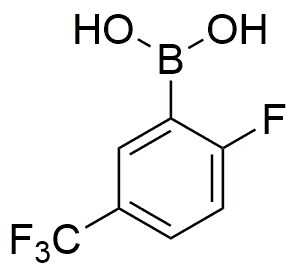2-Fluoro-5-(trifluoromethyl)phenylboronic acid is widely utilized in research focused on:
- Pharmaceutical Development: This compound serves as a key intermediate in the synthesis of various pharmaceuticals, particularly in the development of drugs targeting cancer and other diseases due to its ability to form stable complexes with biological targets.
- Organic Synthesis: It is employed in cross-coupling reactions, such as Suzuki-Miyaura coupling, which allows for the formation of carbon-carbon bonds, essential for creating complex organic molecules.
- Material Science: The compound is used in the development of advanced materials, including polymers and coatings, where its unique properties enhance durability and chemical resistance.
- Fluorinated Compounds: Its fluorine content makes it valuable in synthesizing fluorinated compounds, which are often more stable and lipophilic, improving their bioavailability in medicinal chemistry.
- Analytical Chemistry: This boronic acid derivative is useful in sensor technology, particularly in the detection of sugars and other biomolecules, providing a reliable method for monitoring biological processes.
General Information
Properties
Safety and Regulations
Applications
2-Fluoro-5-(trifluoromethyl)phenylboronic acid is widely utilized in research focused on:
- Pharmaceutical Development: This compound serves as a key intermediate in the synthesis of various pharmaceuticals, particularly in the development of drugs targeting cancer and other diseases due to its ability to form stable complexes with biological targets.
- Organic Synthesis: It is employed in cross-coupling reactions, such as Suzuki-Miyaura coupling, which allows for the formation of carbon-carbon bonds, essential for creating complex organic molecules.
- Material Science: The compound is used in the development of advanced materials, including polymers and coatings, where its unique properties enhance durability and chemical resistance.
- Fluorinated Compounds: Its fluorine content makes it valuable in synthesizing fluorinated compounds, which are often more stable and lipophilic, improving their bioavailability in medicinal chemistry.
- Analytical Chemistry: This boronic acid derivative is useful in sensor technology, particularly in the detection of sugars and other biomolecules, providing a reliable method for monitoring biological processes.
Documents
Safety Data Sheets (SDS)
The SDS provides comprehensive safety information on handling, storage, and disposal of the product.
Product Specification (PS)
The PS provides a comprehensive breakdown of the product’s properties, including chemical composition, physical state, purity, and storage requirements. It also details acceptable quality ranges and the product's intended applications.
Certificates of Analysis (COA)
Search for Certificates of Analysis (COA) by entering the products Lot Number. Lot and Batch Numbers can be found on a product’s label following the words ‘Lot’ or ‘Batch’.
*Catalog Number
*Lot Number
Certificates Of Origin (COO)
This COO confirms the country where the product was manufactured, and also details the materials and components used in it and whether it is derived from natural, synthetic, or other specific sources. This certificate may be required for customs, trade, and regulatory compliance.
*Catalog Number
*Lot Number
Safety Data Sheets (SDS)
The SDS provides comprehensive safety information on handling, storage, and disposal of the product.
DownloadProduct Specification (PS)
The PS provides a comprehensive breakdown of the product’s properties, including chemical composition, physical state, purity, and storage requirements. It also details acceptable quality ranges and the product's intended applications.
DownloadCertificates of Analysis (COA)
Search for Certificates of Analysis (COA) by entering the products Lot Number. Lot and Batch Numbers can be found on a product’s label following the words ‘Lot’ or ‘Batch’.
*Catalog Number
*Lot Number
Certificates Of Origin (COO)
This COO confirms the country where the product was manufactured, and also details the materials and components used in it and whether it is derived from natural, synthetic, or other specific sources. This certificate may be required for customs, trade, and regulatory compliance.


